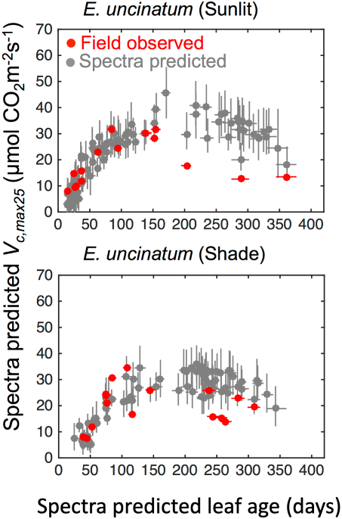The Science
The annual fluxes of carbon in the tropics play a critical role in regulating Earth’s climate and are highly sensitive to global change, however our process representation of the factors regulating tropical carbon uptake and loss in Earth System Models (ESMs) is poor. Tropical photosynthesis is an especially critical process to represent accurately in ESMs, yet we have very limited information on the spatial and temporal patterns of key parameters that regulate leaf level photosynthesis, such as the maximum carboxylation capacity (known as Vc,max). In addition, the tropics have the highest plant diversity of any terrestrial ecosystem on Earth making it very challenging for ESMs to capture the important variation in photosynthetic capacity across tropical species as well as with leaf age. This study investigated the capacity to provide much richer information on the spatial and seasonal variation in tropical Vc,max across a broad range of tree species using a spectroscopic approach, compared with traditional gas exchange methods.
The Impact
The seasonal and spatial variation in photosynthetic capacity of terrestrial vegetation strongly regulates seasonal to annual fluxes of carbon between the land and the atmosphere, yet ESMs currently lack a detailed representation of this variation given data limitations related to the logistical and technical challenges of collecting this data using traditional approaches. On the other hand, our spectroscopic approach presented here can be used to rapidly estimate plant photosynthetic capacity across a range of tropical species, leaf phenological stage, and locations paving the way for a broad-scale remote sensing approach capable of measuring photosynthetic properties over large areas and through time.
Summary
Traditionally, Vc,max is inferred from direct measurements of leaf photosynthetic carbon assimilation rate at saturating light and at different levels of atmospheric CO2 concentration to describe the “CO2 response curve” of a leaf, which is then used to derive the maximum carboxylation capacity, or Vc,max. This direct approach is considered the “gold standard” but is also very time consuming and can be logistically challenging in remote areas, such as the tropics. Instead, we explored the use of spectroscopy to estimate the Vc,max of tropical leaves using only leaf-level reflectance measurements. To do this we collected leaf age and Vc,max data and linked these with measurements of leaf reflectance from a range of species sampled from tropical forests in Panama and Brazil. Our results showed that leaf spectroscopy can rapidly predict Vc,max across our species with high accuracy and low error. We also show that combining spectroscopic models enables the construction of the Vc,max-age relationship solely from leaf reflectance, suggesting that the spectroscopy technique can capture the seasonal variability in Vc,max in the tropics, potentially providing a powerful new way to inform ESMs.

Contacts (BER PM): Daniel Stover, SC-23.1, Daniel.Stover@science.doe.gov (301-903-0289)
PI Contact: Shawn P. Serbin, Brookhaven National Laboratory, sserbin@bnl.gov
Funding
This work was supported by the Next-Generation Ecosystem Experiments (NGEE Tropics) project that is supported by the Office of Biological and Environmental Research in the Department of Energy, Office of Science.
Publications
Wu J, Rogers A, Albert LP, Ely K, Prohaska N, Wolfe BT, Oliveira Jr RC, Saleska SR, Serbin SP. 2019. Leaf reflectance spectroscopy captures variation in carboxylation capacity across species, canopy environment and leaf age in lowland moist tropical forests. New Phytologist 224(2): 663-674.
Related Links
Article URL: https://nph.onlinelibrary.wiley.com/doi/full/10.1111/nph.16029
“Of Leaves and Light” BNL newsroom article: https://www.bnl.gov/newsroom/news.php?a=213279